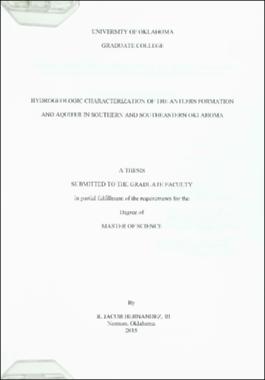| dc.contributor.advisor | Elmore, R. Douglas | |
| dc.contributor.advisor | Murray, Kyle E. | |
| dc.contributor.advisor | Pranter, Mathew J. | |
| dc.creator | Hernandez, R. Jacob, III | |
| dc.date.accessioned | 2018-11-21T22:29:31Z | |
| dc.date.available | 2018-11-21T22:29:31Z | |
| dc.date.issued | 2015 | |
| dc.identifier.citation | Hernandez, R. (2015). Hydrogeologic Characterization of the Antlers Formation and Aquifer in Southern and Southeastern Oklahoma / by R. Jacob Hernandez, III. | |
| dc.identifier.uri | https://hdl.handle.net/11244/302147 | |
| dc.description.abstract | The Cretaceous-aged Antlers Formation crops out in several counties just north of the Texas border in southern and southeastern Oklahoma. The Antlers is composed of sands, conglomerates, clays, and limestones that lie unconformably over Paleozoic rocks, which forms the Antlers Aquifer, the fourth largest aquifer in Oklahoma in terms of storage volume. There have been no hydrogeologic investigations of the aquifer since a 1992 USGS report that estimated the hydraulic conductivity to range from 0.87-3.75 ft/day. In the absence of comprehensive studies of the Antlers, the goals of this study were to examine existing depositional models of the Antlers and understand the geologic controls on the aquifer's hydraulic properties in Marshall, Johnston, and Carter Counties. Field investigations included observations of lithologies and outcrop characteristics. Samples were collected from numerous locations that were spatially distributed throughout the study area. Laboratory studies included grain-size analyses, which were used to estimate hydraulic conductivity of the Antlers. | |
| dc.description.abstract | Based on field observations, the previously postulated depositional environment of deltaic and alluvial fan deposits that transitioned into fluvial environments appears to be reasonable. Sample collection and laboratory analyses resulted in grain size distributions for 35 samples from 10 outcrops. Hydraulic conductivity of the samples ranged from 1.19-198.86 ft/d using the Hazen method. Specific capacity data analysis and slug testing were completed to compare the subsurface hydraulic conductivity (0.11-31.38 ft/ day) to the properties computed for outcrop material. The large range of hydraulic conductivities using the Hazen Equation is consistent with the highly variable lithology observed in the field. The results of the specific capacity tests and slug tests have a larger range and higher values than previous conceptual models and reports on the Antlers. Based on observed outcrop characteristics, laboratory analyses, and field (well) test results, this study shows that a more heterogeneous Antlers is present in the surface and subsurface with a broader range and higher average hydraulic conductivity than was previously reported. | |
| dc.format.extent | 75 pages | |
| dc.format.extent | 20,738,812 bytes | |
| dc.format.medium | application.pdf | |
| dc.language | en_US | |
| dc.subject | Hydrogeology -- Oklahoma | |
| dc.subject | Aquifers -- Oklahoma | |
| dc.subject | Conoco Phillips School of Geology and Geophysics | |
| dc.title | Hydrogeologic characterization of the Antlers Formation and aquifer in southern and southeastern Oklahoma | |
| dc.type | text | |
| ou.group | Mewbourne College of Earth and Energy::ConocoPhillips School of Geology and Geophysics | |
